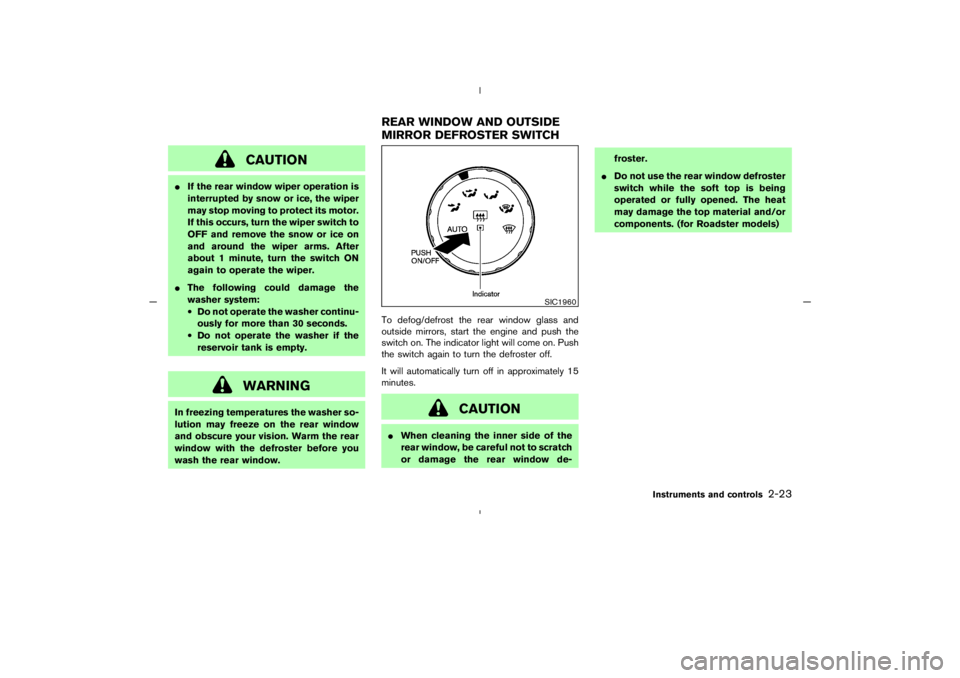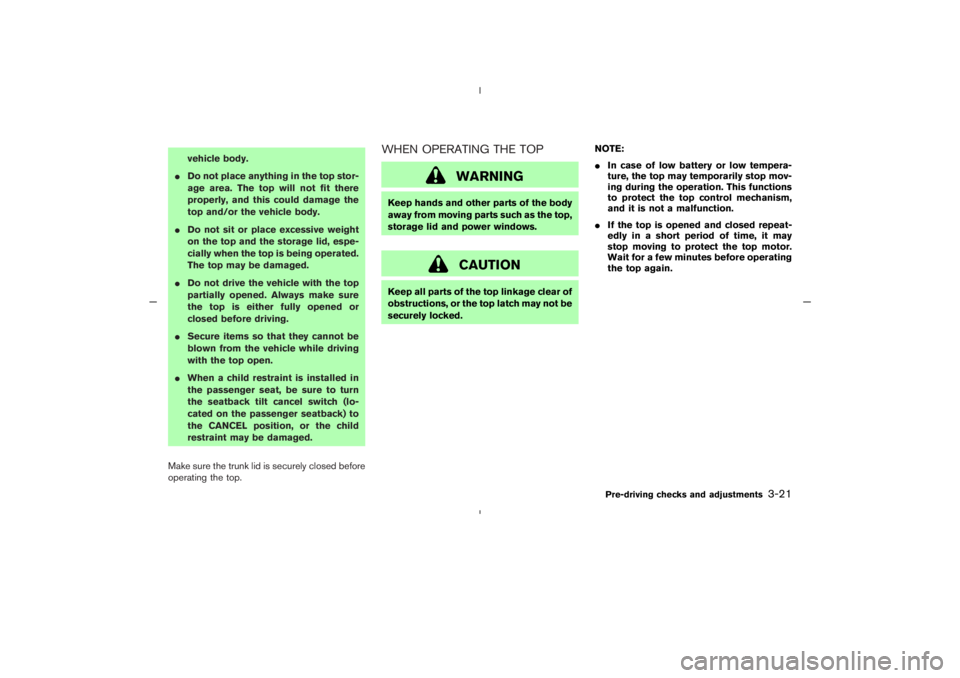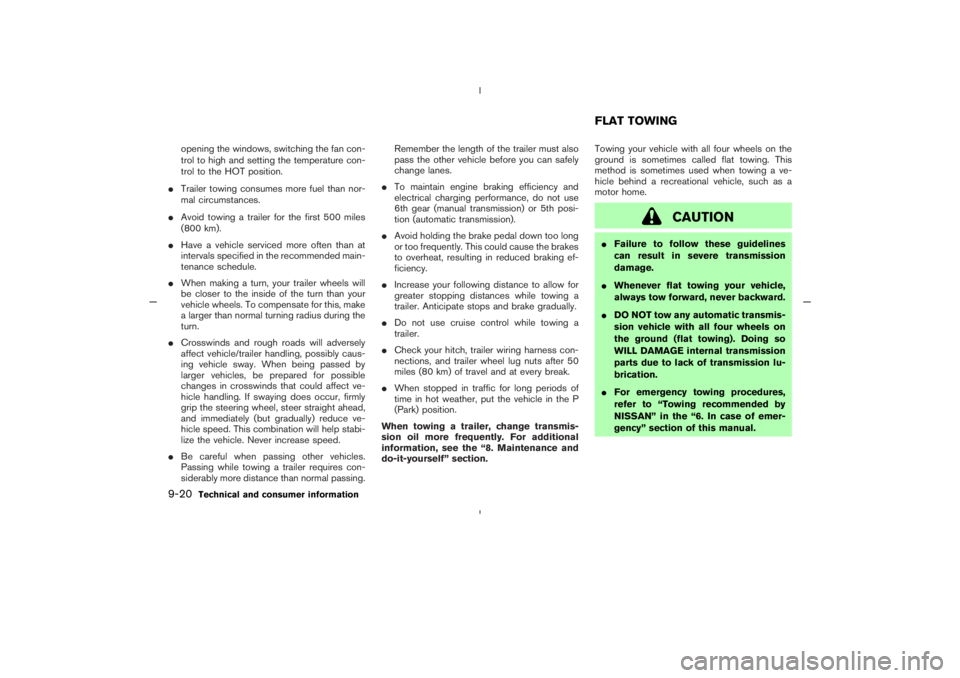Page 80 of 279

CAUTION
�If the rear window wiper operation is
interrupted by snow or ice, the wiper
may stop moving to protect its motor.
If this occurs, turn the wiper switch to
OFF and remove the snow or ice on
and around the wiper arms. After
about 1 minute, turn the switch ON
again to operate the wiper.
�The following could damage the
washer system:
•Do not operate the washer continu-
ously for more than 30 seconds.
•Do not operate the washer if the
reservoir tank is empty.
WARNING
In freezing temperatures the washer so-
lution may freeze on the rear window
and obscure your vision. Warm the rear
window with the defroster before you
wash the rear window.To defog/defrost the rear window glass and
outside mirrors, start the engine and push the
switch on. The indicator light will come on. Push
the switch again to turn the defroster off.
It will automatically turn off in approximately 15
minutes.
CAUTION
�When cleaning the inner side of the
rear window, be careful not to scratch
or damage the rear window de-froster.
�Do not use the rear window defroster
switch while the soft top is being
operated or fully opened. The heat
may damage the top material and/or
components. (for Roadster models)
SIC1960
REAR WINDOW AND OUTSIDE
MIRROR DEFROSTER SWITCH
Instruments and controls
2-23
�
04.8.23/Z33-D/V5.0
�
Page 124 of 279

vehicle body.
�Do not place anything in the top stor-
age area. The top will not fit there
properly, and this could damage the
top and/or the vehicle body.
�Do not sit or place excessive weight
on the top and the storage lid, espe-
cially when the top is being operated.
The top may be damaged.
�Do not drive the vehicle with the top
partially opened. Always make sure
the top is either fully opened or
closed before driving.
�Secure items so that they cannot be
blown from the vehicle while driving
with the top open.
�When a child restraint is installed in
the passenger seat, be sure to turn
the seatback tilt cancel switch (lo-
cated on the passenger seatback) to
the CANCEL position, or the child
restraint may be damaged.
Make sure the trunk lid is securely closed before
operating the top.
WHEN OPERATING THE TOP
WARNING
Keep hands and other parts of the body
away from moving parts such as the top,
storage lid and power windows.
CAUTION
Keep all parts of the top linkage clear of
obstructions, or the top latch may not be
securely locked.NOTE:
�In case of low battery or low tempera-
ture, the top may temporarily stop mov-
ing during the operation. This functions
to protect the top control mechanism,
and it is not a malfunction.
�If the top is opened and closed repeat-
edly in a short period of time, it may
stop moving to protect the top motor.
Wait for a few minutes before operating
the top again.
Pre-driving checks and adjustments
3-21
�
04.8.23/Z33-D/V5.0
�
Page 263 of 279

opening the windows, switching the fan con-
trol to high and setting the temperature con-
trol to the HOT position.
�Trailer towing consumes more fuel than nor-
mal circumstances.
�Avoid towing a trailer for the first 500 miles
(800 km).
�Have a vehicle serviced more often than at
intervals specified in the recommended main-
tenance schedule.
�When making a turn, your trailer wheels will
be closer to the inside of the turn than your
vehicle wheels. To compensate for this, make
a larger than normal turning radius during the
turn.
�Crosswinds and rough roads will adversely
affect vehicle/trailer handling, possibly caus-
ing vehicle sway. When being passed by
larger vehicles, be prepared for possible
changes in crosswinds that could affect ve-
hicle handling. If swaying does occur, firmly
grip the steering wheel, steer straight ahead,
and immediately (but gradually) reduce ve-
hicle speed. This combination will help stabi-
lize the vehicle. Never increase speed.
�Be careful when passing other vehicles.
Passing while towing a trailer requires con-
siderably more distance than normal passing.Remember the length of the trailer must also
pass the other vehicle before you can safely
change lanes.
�To maintain engine braking efficiency and
electrical charging performance, do not use
6th gear (manual transmission) or 5th posi-
tion (automatic transmission).
�Avoid holding the brake pedal down too long
or too frequently. This could cause the brakes
to overheat, resulting in reduced braking ef-
ficiency.
�Increase your following distance to allow for
greater stopping distances while towing a
trailer. Anticipate stops and brake gradually.
�Do not use cruise control while towing a
trailer.
�Check your hitch, trailer wiring harness con-
nections, and trailer wheel lug nuts after 50
miles (80 km) of travel and at every break.
�When stopped in traffic for long periods of
time in hot weather, put the vehicle in the P
(Park) position.
When towing a trailer, change transmis-
sion oil more frequently. For additional
information, see the “8. Maintenance and
do-it-yourself” section.Towing your vehicle with all four wheels on the
ground is sometimes called flat towing. This
method is sometimes used when towing a ve-
hicle behind a recreational vehicle, such as a
motor home.
CAUTION
�Failure to follow these guidelines
can result in severe transmission
damage.
�Whenever flat towing your vehicle,
always tow forward, never backward.
�DO NOT tow any automatic transmis-
sion vehicle with all four wheels on
the ground (flat towing). Doing so
WILL DAMAGE internal transmission
parts due to lack of transmission lu-
brication.
�For emergency towing procedures,
refer to “Towing recommended by
NISSAN” in the “6. In case of emer-
gency” section of this manual.FLAT TOWING
9-20
Technical and consumer information
�
04.8.23/Z33-D/V5.0
�